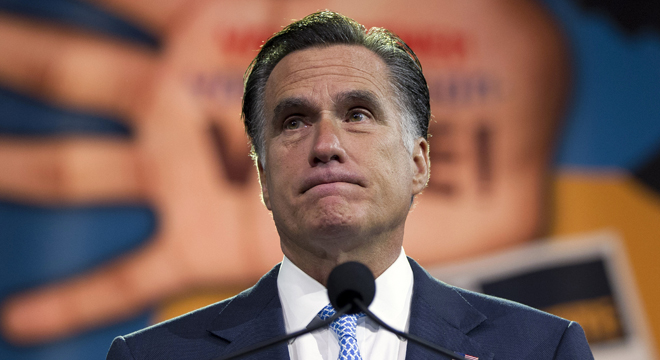Conservatives fear that President Obama’s wave of attacks on Mitt Romney’s business record and tax returns are succeeding at defining the Republican nominee. A key reason this is working, they say, is that Romney has failed to define himself — and his tax platform offers a compelling window into this phenomenon.
If only Romney emulated the conservative candidate they’ve long yearned for, they argue, he could insulate himself from attacks on his business record, unreleased tax returns, and anything else Obama might throw his way.
At a glance, these might appear to be unrelated issues. What do Romney’s personal finances and private sector career have to do with his social and economic policy bona fides?
Directly, very little. But an obvious tension between Romney’s desire to appeal to conservative power players without alienating the middle- and working-class voters he needs to win in November underscores their point. if he can’t rebut attacks on his business career and his finances, and he can’t tout his key gubernatorial achievement ‘Romneycare’, he ought to have at least one issue to champion. Yet even when it comes to the right’s top issue — taxes — Romney’s hedging has left him friendless; middle class voters see him championing tax breaks for the wealthy, and conservatives aren’t sure he’ll follow through on their goals of forcing major cuts to the safety net and other domestic programs, while preventing significant cuts to defense spending.
Under persistent pressure from the right during the GOP primary, Romney released a revised tax plan late in February pledging to reduce all tax rates by 20 percent, establishing a top individual rate of 28 percent. A campaign spokesperson tells TPM the plan remains current.
The presumptive Republican nominee’s chief economic adviser Glenn Hubbard told CNBC the plan would slash each of the six tax brackets from their Bush-era rates — 10, 15, 25, 28, 33, and 35 percent — down to 8, 12, 20, 22.4, 26.4, and 28 percent, respectively. He also wants to cut the corporate tax rate to 25 percent.
At the same time, he claims his plan will be deficit neutral, and that he’ll close out longer-term deficits by cutting unspecified federal programs over time.
This presents an important contrast with President Obama’s vision.
Obama wants to keep existing marginal rates for all but the highest earners, while allowing the rate on incomes over $250,000 to return to Clinton-era levels of 39.6 percent.
On the surface, that difference lets Romney present himself as a tax-cutter and call the president a tax hiker. It even allows him to claim he’d provide the middle class a tax cut that Obama’s not offering. But on a deeper level it exposes Romney’s core vulnerability — not merely because, as liberals have claimed, he stands to benefit financially from his own plan, but because his numbers do not add up. And that brings the entire proposal into question.
Extending the existing top marginal rate would cost $800 billion over 10 years. Romney’s proposal to slash rates by an additional 20 percent would add $3.4 trillion more to the deficit, according to the nonpartisan Tax Policy Center.
That alone would be a huge blow to the federal budget.
Romney has vowed to fill the hole by closing tax loopholes, although he has refused to specify any. In a private “hot mic” moment during an April fundraiser, Romney mentioned several deductions he might eliminate, but those would only raise a small fraction of the lost revenues. His campaign nevertheless backed off those specifics.
Much of the annual $1 trillion in federal tax deductions, such as home mortgage interest and employer-provided health care, benefit the middle class and have tremendous support in Congress. Other perks such as the low capital gains rate and oil and gas tax subsidies have the muscle of powerful constituencies and Republicans in particular have fought to protect them. That raises further questions about whether Romney’s promise is serious.
At the same time, Obama’s plan would raise enough revenue to replace automatic cuts to defense and non-defense programs scheduled to kick in early next year — a big chunk of the so-called “fiscal cliff.” Romney by contrast has been largely silent about how to avoid those cuts, known as “sequestration.”
Romney has also championed a GOP-sponsored amendment to the Constitution requiring the federal government to run a balanced budget, which would effectively make his own plan — to the extent that it’s specific — invalid.
The messy tax proposal illuminates Romney’s challenge. Obama’s attacks on his record at Bain Capital, offshore bank accounts and unreleased tax returns “are sticking to Romney like Velcro,” warned election analyst Charlie Cook, who said they present “a clear and immediate danger” to the GOP nominee’s electability. One way to define himself in favorable terms is to offer clear, compelling policy proposals that reveal his values. But Romney’s hazy platform has allowed Obama define him across all issues. And the president is taking full advantage of it.










